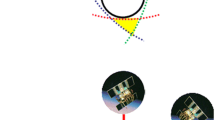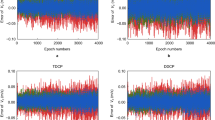Abstract
The Doppler effect is the apparent shift in frequency of an electromagnetic signal that is received by an observer moving relative to the source of the signal. The Doppler frequency shift relates directly to the relative speed between the receiver and the transmitter, and has thus been widely used in velocity determination. A GPS receiver-satellite pair is in the Earth’s gravity field and GPS signals travel at the speed of light, hence both Einstein’s special and general relativity theories apply. This paper establishes the relationship between a Doppler shift and a user’s ground velocity by taking both the special and general relativistic effects into consideration. A unified Doppler shift model is developed, which accommodates both the classical Doppler effect and the relativistic Doppler effect under special and general relativities. By identifying the relativistic correction terms in the model, a highly accurate GPS Doppler shift observation equation is presented. It is demonstrated that in the GPS “frequency” or “velocity” domain, the relativistic effect from satellite motion changes the receiver-satellite line-of-sight direction, and the measured Doppler shift has correction terms due to the relativistic effects of the receiver potential difference from the geoid, the orbit eccentricity, and the rotation of the Earth.
Similar content being viewed by others
References
RINC (2000) Interface control document, navstar GPS space segment/navigation user interfaces. ICD-GPS-200, revision C. ARINC Research Corporation, San Diego
Ashby N (2003) Relativity in the global positioning system. Living review of relativity 6, online article, http://www.livingreviews.org/Articles/Volum6/2003-lashby. Accessed on 08/12/2004
Ashby N, Spilker JJ (1996) Introduction to relativistic effects on the global positioning system. In: Parkinson BW, Spilker JJ (eds) Global positioning system: theory and applications, vol 1. American Institute of Aeronautics and Astronautics, Washington, pp 623–698
Audoin C, Guinot B (2001) The measurement of time: time, and the atomic clock. Cambridge University Press, Cambridge, New York
DoD (1996) NAVSTAR GPS user equipment introduction. Public release version, Department of Defense, Washington
Hofmann-Wellenhof B, Lichtenegger H, Collins J (2001) Global positioning system theory and practice. Springer, Wien New York
van Graas F, Soloview A (2003) Precise velocity estimation using a stand-alone GPS receiver. In: Proceedings of ION-NTM 2003, Anaheim, pp 262–271
IAU Resolutions (2000) IAU resolutions adopted at the 24th general assembly. http://danof.obspm.fr/IAU_resolutions/Resol-UAI.htm. Accessed on 08/12/2004
Kouba J (2002) Relativistic time transformations in GPS. GPS Solut 5(4):1–9
Kouba J (2004) Improved relativistic transformations in GPS. GPS Solut 8(3):170–180
Leva J, Haag M, Dyke K (1996) Performance of standalone GPS. In: Kaplan ED (eds) Understanding GPS: principles and applications. Artech House, Boston London, pp 237–320
Misra P, Enge P (2001) Global positioning system: signals, measurements, and performance. Ganga-Jamuna Press, Lincoln
Montenbruck O, Gill E (2000) Satellite orbits: models, methods, and applications. Springer, Berlin Heidelberg New York
NIMA (2000) World geodetic system 1984: its definition and relationships with local geodetic systems. Report TR8350.2, National Imagery and Mapping Agency, Washington
Seeber G (1993) Satellite geodesy: foundations, methods, and applications. Walter de Gruyter, Berlin
Seeber G (2003) Satellite geodesy, 3rd Ed. Walter de Gruyter, Berlin
Serrano L, Kim D, Langley RB, Itani K, Ueno M (2004) A GPS Velocity sensor: how accurate can it be? A first look. In: Proceedings of ION-NTM 2004, San Diego, pp 875–885
Serway R (1996) Physics for scientists & engineers with modern physics. Saunders College Publishing, Tokyo
Wells D, Beck B, Delikaraoglou D, Kleusberg A, Krakiwsky E, Lachapelle G, Langley R, Nakiboglu M, Schwarz K, Tranquilla J, Vaníček P (1987) Guide to GPS positioning. Canadian GPS Associates, Fredericton
Author information
Authors and Affiliations
Corresponding author
Rights and permissions
About this article
Cite this article
Zhang, J., Zhang, K., Grenfell, R. et al. Short Note: On the Relativistic Doppler Effect for Precise Velocity Determination using GPS. J Geodesy 80, 104–110 (2006). https://doi.org/10.1007/s00190-006-0038-8
Received:
Accepted:
Published:
Issue Date:
DOI: https://doi.org/10.1007/s00190-006-0038-8




